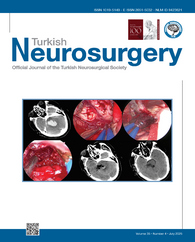2Second Affiliated Hospital of Nanjing Medical University, Department of Neurosurgery, Nanjing, Jiangsu Province, China DOI : 10.5137/1019-5149.JTN.46394-24.2 AIM: To summarise atypical cases of hemifacial spasm (HFS) found during microvascular decompression (MVD), and to investigate its pathogenesis and range of exploration.
MATERIAL and METHODS: We retrospectively analysed cases of HFS performed in our department in recent years and summarised the intraoperative electrophysiological monitoring findings, vascular and nerve exploration, and postoperative symptoms. We then discussed the pathogenesis of and treatment for atypical HFS.
RESULTS: In total, 85 cases of facial nerve MVD were performed in the past 3 years, of which 77 (90.6%) were responsible factors in the root exit zone (REZ) and eight (9.4%) in the non-REZ. For patients without vascular compression of the REZ, the compression factors outside the REZ were separated, and the arachnoid band around the facial nerve was released; subsequently, the amplitude of the abnormal muscle response of the facial nerve diminished or disappeared. Facial twitch symptoms disappeared or improved significantly after surgery. Most symptoms disappeared after 3 months of postoperative follow-up.
CONCLUSION: Factors responsible for non-REZ observed during MVD of the facial nerve are not rare. It is suggested that fulllength exploration should be performed during facial nerve MVD under electrophysiological monitoring.
Keywords : Hemifacial spasm, Microvascular decompression, Intraoperative electrophysiology, Abnormal muscle response




